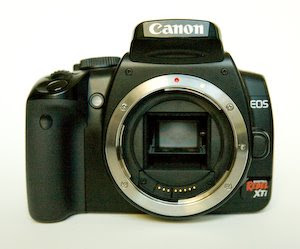


You're ready to junk the point and shoot. You've been reading photo forums for years. You've taken digi-photog classes. You understand white balancing, color temperature, ambient light, ISO speeds, RAW, and aperture. You're dialed in. You're ready to graduate to a more advanced shooter.
But where to start?
The Canon's Rebel XTi is a cost-effective way to knock your digital photography up a crucial notch. Spouting a 10.1 megapixel CMOS sensor, a 2.5-inch LCD display, and the ability to fire off 3 frames per second, it's light years away from any point and shoot out there but is it really the first stop you want to make on the the road to prosumer DSLR nirvana?
The truth is, it's not a bad jumping off point. The XTi features more than enough shooting options to keep the emerging photographer content. 10.1 megapixels provide ample resolution for printing photos — even up to 13 x 19-inches. The frame-rate, although not as fast as Canon's more advanced offerings (like the EOS 40D) is great for taking sharp pics with great color and little noise. The 2.5-inch LCD is great for viewing your snaps or tweaking settings in large, easy-to-read text.
Switching from a point and shooter to a DSLR also unleashes a whole new set of problems. Chief among them is dust. Once a lens is removed from the body of a camera, CMOS sensors within the camera generate an electrical charge that attracts airborne particles like Brit-Brit attracts straitjackets. You won't even notice the dust until you go to shoot (pictures of) aunt Mavis on her 108th birthday only to find her splotched with gray flecks. The argument could be made that aunt Mavis is already splotched with gray flecks since she's older than the Panama Canal; try taking a picture of a less desiccated relative — you'll see the same thing. Canon has a two-pronged solution to this which includes a cleaning system that runs every time you switch on or off your camera and a way to make dust spots so you can deal with their effects in software.
The XTi has a few issues that make it less than perfect. The first, and most minor of quibbles is the lack of data entry wheel on the back of the body. This flaw forces you to hold a button and spin the top wheel to adjust the exposure compensation. Secondly, the camera feels, well, small in hand. (For the record I don't have large hands.) Third, the plastic build quality feels cheap compared to Canon's 20/30/40D/5D bodies which are all magnesium.
The Canon Rebel XTi is a great starter SLR for amateur photographers wanting to improve the quality of their shots. For the money you can't go wrong, especially considering the price will plummet once the newer XSi has been out on shelves for a while. So really, what are you waiting for? Oh the XSi to be reviewed? Don't worry, we'll have a write-up on it very soon. —Dave Bullock
WIRED Low-cost entry level SLR with tons of features from its higher priced siblings. 10.1 megapixels of image capturing hotness. Dust zapping, sensor shaking cleaning system.
TIRED Feels small and a little chintzy. Plastic body build quality feels cheaper than the more expensive Canon bodies.
$600 ($550 street, soon to be less)
No comments:
Post a Comment